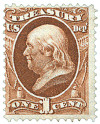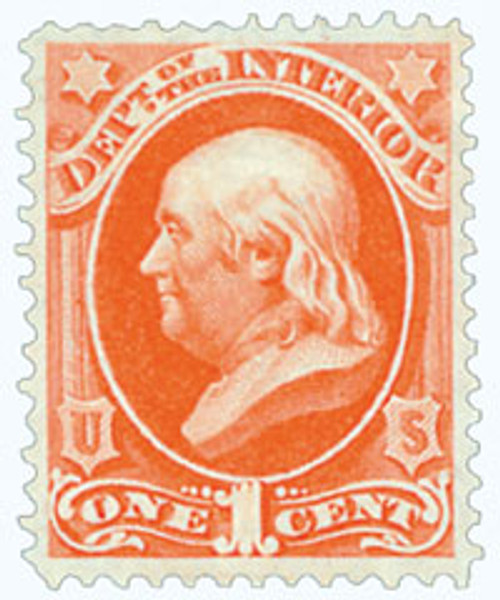
# O72 - 1873 1c Brown, Treasury Department, Franklin, Hard Paper
1873 1¢ Franklin
Official Stamp – Treasury
U.S. Treasury Department Founded
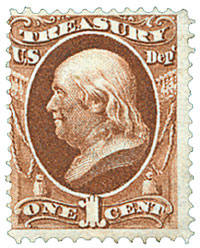
In the wake of the American Revolution, Congress established the Treasury Department on September 2, 1789.
During the Revolutionary War, the new American government needed a way to pay for the mounting costs of battle. Congress first appointed a pair of Joint Continental Treasurers to manage finances. After declaring its independence in 1776, America became a sovereign nation that could secure loans from other countries. To oversee the influx of foreign and American money, Michael Hillegas was appointed Treasurer of the United States on May 14, 1777. He was followed by Robert Morris as Superintendent of Finance.
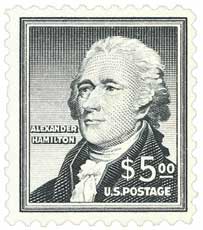
On March 4, 1789, Congress met for the first time under the Constitution. Later that year, on September 2, Congress created a permanent position to manage government finances – Secretary of the Treasury. Alexander Hamilton was made the first Secretary of the Treasury on September 11.
Hamilton was responsible for laying the groundwork for our nation’s economic policies. He established a national bank, a tariff system on imports, and friendly relations with England.
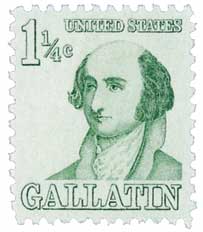
The Treasury Department has been reorganized and changed over the past 225 years, though it’s mission is the same – ensure the nation’s financial security. Since its beginning, the U.S. has had debt, usually as a result of war. To cover these costs, money is borrowed from foreign governments and private citizens. The Treasury also advises Congress on financial policies within the country and with other governments, which includes trade agreements and taxes.
Other Treasury Secretaries Honored on U.S. Stamps
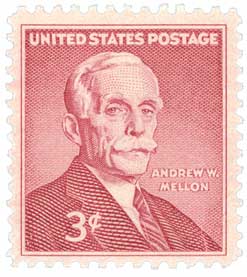
With Thomas Jefferson’s election to President in 1801, Albert Gallatin began a 13-year service as U.S. Secretary of the Treasury – the longest of any person in this position. In this role, he successfully balanced the federal budget and was largely responsible for avoiding a tax increase following the Louisiana Purchase. He also helped map out the Lewis and Clark Expedition.
Banker, businessman, and industrialist Andrew W. Mellon became Secretary of the Treasury in 1921. He was tasked with reducing America’s large debt following World War I. He overhauled the tax system and cut the federal debt by $10 billion dollars in under 10 years.
1873 1¢ Franklin
Official Stamp – Treasury
U.S. Treasury Department Founded

In the wake of the American Revolution, Congress established the Treasury Department on September 2, 1789.
During the Revolutionary War, the new American government needed a way to pay for the mounting costs of battle. Congress first appointed a pair of Joint Continental Treasurers to manage finances. After declaring its independence in 1776, America became a sovereign nation that could secure loans from other countries. To oversee the influx of foreign and American money, Michael Hillegas was appointed Treasurer of the United States on May 14, 1777. He was followed by Robert Morris as Superintendent of Finance.

On March 4, 1789, Congress met for the first time under the Constitution. Later that year, on September 2, Congress created a permanent position to manage government finances – Secretary of the Treasury. Alexander Hamilton was made the first Secretary of the Treasury on September 11.
Hamilton was responsible for laying the groundwork for our nation’s economic policies. He established a national bank, a tariff system on imports, and friendly relations with England.

The Treasury Department has been reorganized and changed over the past 225 years, though it’s mission is the same – ensure the nation’s financial security. Since its beginning, the U.S. has had debt, usually as a result of war. To cover these costs, money is borrowed from foreign governments and private citizens. The Treasury also advises Congress on financial policies within the country and with other governments, which includes trade agreements and taxes.
Other Treasury Secretaries Honored on U.S. Stamps

With Thomas Jefferson’s election to President in 1801, Albert Gallatin began a 13-year service as U.S. Secretary of the Treasury – the longest of any person in this position. In this role, he successfully balanced the federal budget and was largely responsible for avoiding a tax increase following the Louisiana Purchase. He also helped map out the Lewis and Clark Expedition.
Banker, businessman, and industrialist Andrew W. Mellon became Secretary of the Treasury in 1921. He was tasked with reducing America’s large debt following World War I. He overhauled the tax system and cut the federal debt by $10 billion dollars in under 10 years.



